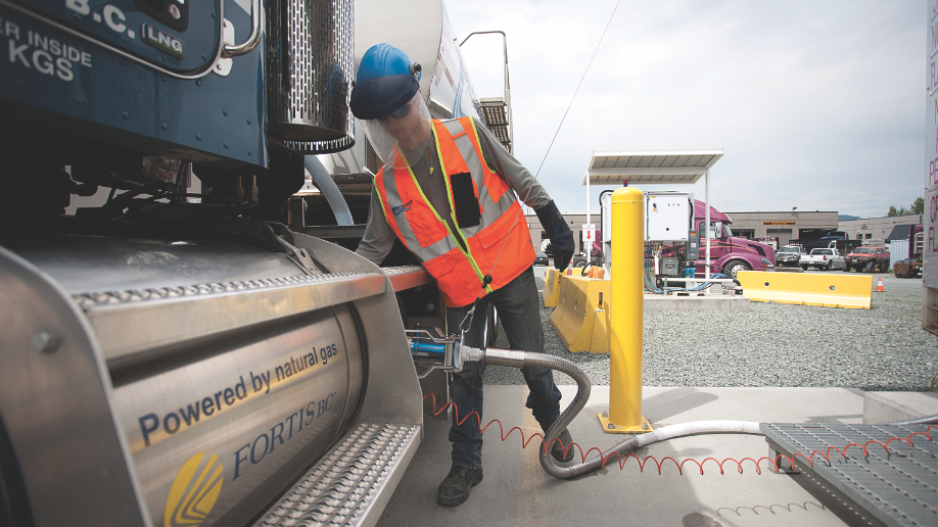Among the concerns being raised over new provincial regulations for liquefied natural gas development is that other sectors in B.C. might have to shoulder more of the burden for reducing greenhouse gases so the province can have an LNG industry and still meet its GHG reduction targets.
Perhaps ironically, a growing domestic LNG market might help achieve some of those reductions, as remote communities and the trucking and shipping industries make the switch from diesel to cheaper, cleaner-burning natural gas.
FortisBC and AltaGas Ltd. (TSX:ALA) are planning hundreds of millions of dollars worth of investments in LNG plants over the next couple of years to serve a growing domestic market for LNG.
Last week, FortisBC turned sod on a $400 million expansion of its existing LNG plant on Tilbury Island in Delta. The expansion – slated for completion in late 2016 – is being driven by a growing domestic demand for LNG by the trucking and marine industries.
However, there’s also the possibility that the expanded plant could supply gas for a U.S. company, WesPac Midstream LLC, which has applied for an export licence. If granted, the company could ship LNG supplied by FortisBC from a marine terminal adjacent to the Tilbury plant to “regional and offshore markets.”
There has been a natural gas liquefaction plant and LNG storage tank on Tilbury Island since 1971. FortisBC and its predecessors have used it in the winter as backup, when demand for natural gas spikes. In recent years, however, FortisBC has been developing new customers for LNG, primarily in the transportation sector.
When the expansion is complete, the Tilbury Island storage capacity will double and daily production capacity at its liquefaction facilities (which will be driven by grid power, not gas) will increase to 34,000 gigajoules from 5,000.
FortisBC is providing $17.5 million worth of incentives designed to help to help trucking fleets in B.C. convert up to 400 trucks to LNG or compressed natural gas.
The incentives would also cover up to five conversions for large ships, including BC Ferries’ Spirit of Vancouver and Spirit of British Columbia, which are scheduled to be converted to run on natural gas by 2018.
“Together these vehicles will reduce greenhouse gas emissions to the equivalent of 8,000 passengers cars off our roads each year,” said John Walker, executive vice-president of western Canadian operations for Fortis Inc. (TSX:FTS), FortisBC’s parent company.
About 200 semi-trucks in B.C. have been converted to LNG.
Wheeler Transport is one of four trucking companies in B.C. to convert their trucks from diesel to LNG. It converted 10 of its trucks to LNG earlier this year. FortisBC covered 70% of the cost of the conversions. LNG is not just cleaner than diesel, it’s also cheaper, so the company expects it will save money in the long run.
“We’re saving approximately $2,500 to $3,000 per month per tractor,” said Wheeler Transport vice-president Tony Spring.
Vedder Transport Ltd., Arrow Transportation Systems Inc., and Denwill Enterprises Inc. have also converted their fleets to LNG.
LNG produced by FortisBC also holds promise in remote communities that still get their electricity from diesel-powered generators. FortisBC trucks LNG as far as Inuvik, which now generates 25% of its power from LNG.
It’s not just the marine and trucking sectors that are moving to LNG. So are heavy industries, like mining and the oil and gas sectors.
AltaGas is getting in on the ground floor with plans to spend up to $250 million on a number of small liquefaction plants in Northern B.C. to supply LNG for the machines and vehicles used by heavy industry.
“It’s very cost-effective for our customers, as well as reducing CO2 emissions,” AltaGas CEO David Cornhill told Business in Vancouver.
The first LNG plant will be built in Dawson Creek, at a cost of $20 million to $30 million.
“We can see a build-out up to a quarter billion dollars,” Cornhill said.
Matt Horne, associate regional director for the Pembina Institute, doesn’t think the increased use of LNG domestically will significantly counter emissions from an LNG export sector.
“Switching to LNG does have some carbon benefit in the near to medium term,” Horne said, although he added that the reductions from switching to LNG were already counted on in the province’s Climate Action Plan.
“In a lot of these applications, the economic case can be very strong. The environmental case is probably a wash.” •




